change time MITSUBISHI OUTLANDER 2020 (in English) Workshop Manual
[x] Cancel search | Manufacturer: MITSUBISHI, Model Year: 2020, Model line: OUTLANDER, Model: MITSUBISHI OUTLANDER 2020Pages: 443, PDF Size: 60.03 MB
Page 364 of 443

How to change a tire
For emergencies 8-11
8
17. After driving for 10 minutes or 3 miles (5
km), park the vehicl
e in a safe place.
Remove the air compressor from the stowed position. Check the tire pressureusing the air pressure gauge on the com- pressor. If the tire pressure has not dropped, the emergency repair procedureis complete. Proceed to step 19. If the tire pressure is insufficient, inflate the tire to the specified pressure again anddrive the vehicle carefully without exceeding a speed of 50 mph (80 km/h). Before driving, make sure that the com-pressor is stowed.
18. After driving for 10 minutes or 3 miles (5
km) again, check the tire pressure usingthe air pressure gauge on the compressor. If the tire pressure has not dropped, the emergency repair procedure is complete.Before driving, make sure that the com- pressor is stowed. You must still not exceed a speed of 50 mph (80 km/h).Observe local speed limits.
19. Immediately drive with great care to an
authorized Mitsubishi
Motors dealer and
have the tire repa
ir/replacement per-
formed.
N00836901829
Before changing a tire,
first stop your vehicle
in a safe, flat location. 1. Park the vehicle on level and stable ground. 2. Set the parking brake firmly. 3. Move the selector lever to the “P”(PARK) position and turn the ignition switch (the engine switch) to the “LOCK” or “OFF” position.4. Turn on the hazard warning flashers and set up a warning sign, such as a warning triangle or flashing signal lamp, at an ade-quate distance from the vehicle, and have all your passengers
leave the vehicle.
CAUTIONIf you sense any abnormality while driving, stop the vehicle and c
ontact an authorized
Mitsubishi Motors dealer. Otherwise the tirepressure may drop before the emergency repair procedure is completed, rendering the vehicle unsafe to drive.CAUTION If the tire pressure is lower than the mini- mum permitted pressure (18 psi {130 kPa}), the tire cannot successf
ully be repaired with
the tire sealant. Do not drive the vehicle anyfurther. Contact an authorized Mitsubishi Motors dealer.
NOTE
If the tire pressure has dropped below the specified level when you check it at the end of the repair procedure, do not drive the vehicle any further.
Contact an authorized
Mitsubishi Moto
rs dealer.
In cold conditions (when the ambient tem- perature is 32 °F {0 °C} or lower), the time and driving distance required until comple- tion of the repair can
become longer than in
warmer conditions, and the tire pressure may drop below the specified level even after you have inflated the tire the second time andsubsequently driven the vehicle. If this hap- pens, inflate the tire to the specified pressure once more, drive for approximately 10 min-utes or 3 miles (5 km), then check the tire pressure again. If the tire pressure has again dropped below the specified level, stop driv-ing the vehicle and contact an authorized Mitsubishi Moto
rs dealer.
NOTE
Please give the empt
y sealant bottle to an
authorized Mitsubishi Motors dealer or dis-pose of the sealant bot
tle according to regu-
lations for the disposal
of chemical waste.
To purchase a new tire
sealant bottle, contact
an authorized Mitsubishi Motors dealer.
How to change a tire
BK0278200US.book 11 ページ 2019年4月10日 水曜日 午前10時59分
Page 365 of 443
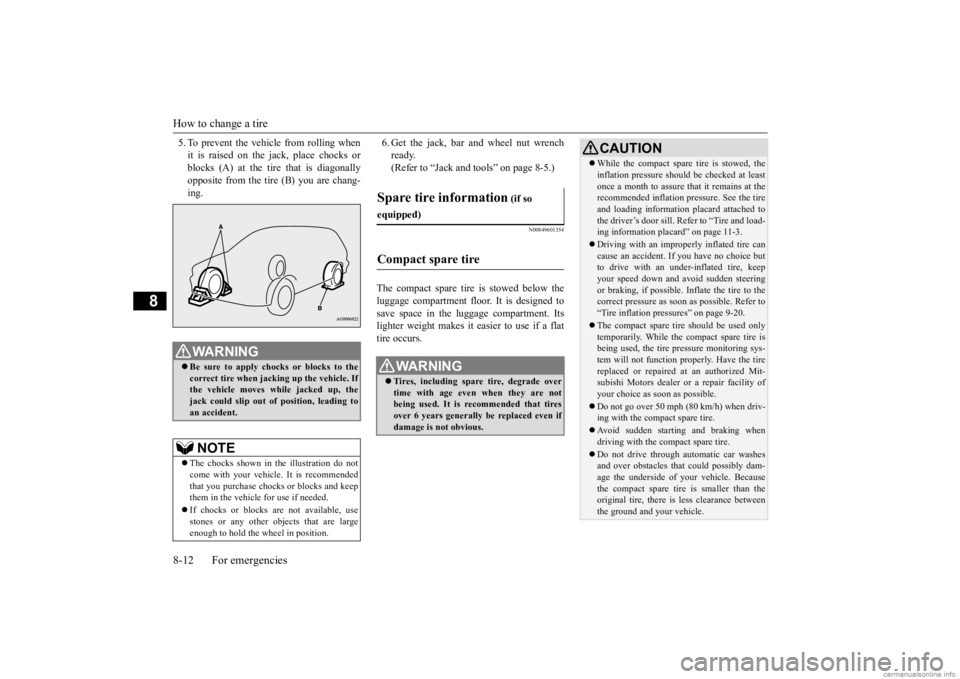
How to change a tire 8-12 For emergencies
8
5. To prevent the vehicle from rolling when it is raised on the jack, place chocks orblocks (A) at the ti
re that is diagonally
opposite from the tire (B) you are chang- ing.
6. Get the jack, bar and wheel nut wrench ready.(Refer to “Jack and t
ools” on page 8-5.)
N00849601354
The compact spare tire is stowed below the luggage compartment floor. It is designed to save space in the luggage compartment. Its lighter weight ma
kes it easier to use if a flat
tire occurs.
WA R N I N G Be sure to apply choc
ks or blocks to the
correct tire when jacking up the vehicle. If the vehicle moves while jacked up, the jack could slip out of
position, leading to
an accident.NOTE
The chocks shown in the illustration do not come with your vehicle. It is recommended that you purchase chocks
or blocks and keep
them in the vehicle for use if needed. If chocks or blocks ar
e not available, use
stones or any other obj
ects that are large
enough to hold the wheel in position.
Spare tire information
(if so
equipped)Compact spare tire
WA R N I N G Tires, including spar
e tire, degrade over
time with age even when they are not being used. It is recommended that tires over 6 years generally
be replaced even if
damage is not obvious.
CAUTION While the compact spare tire is stowed, the inflation pressure shoul
d be checked at least
once a month to assure that it remains at therecommended inflation pressure. See the tire and loading information placard attached to the driver’s door sill. Refer to “Tire and load-ing information placard” on page 11-3. Driving with an imprope
rly inflated tire can
cause an accident. If
you have no choice but
to drive with an under-inflated tire, keep your speed down and av
oid sudden steering
or braking, if possible. Inflate the tire to the correct pressure as soon as possible. Refer to “Tire inflation pressures” on page 9-20. The compact spare tire should be used only temporarily. While th
e compact spare tire is
being used, the tire pr
essure monitoring sys-
tem will not function pr
operly. Have the tire
replaced or repaired at an authorized Mit-subishi Motors dealer or a repair facility of your choice as soon as possible. Do not go over 50 mph (80 km/h) when driv- ing with the compact spare tire. Avoid sudden starting and braking when driving with the
compact spare tire.
Do not drive through automatic car washes and over obstacles that
could possibly dam-
age the underside of your vehicle. Becausethe compact spare tire is smaller than the original tire, there is less clearance between the ground and your vehicle.
BK0278200US.book 12 ページ 2019年4月10日 水曜日 午前10時59分
Page 368 of 443
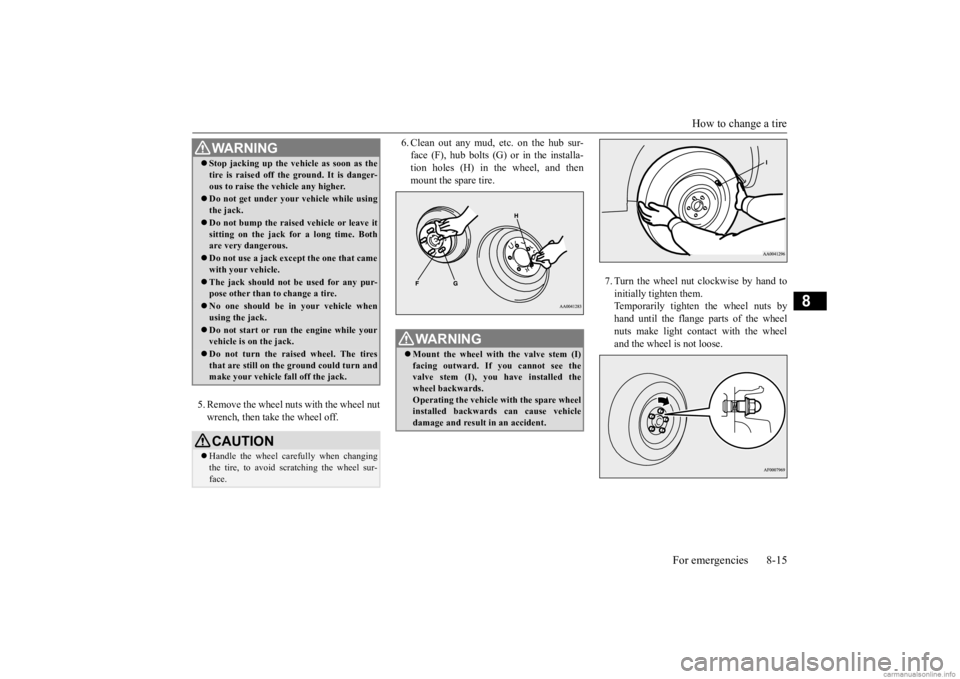
How to change a tire
For emergencies 8-15
8
5. Remove the wheel nuts with the wheel nut wrench, then take the wheel off.
6. Clean out any mud, etc. on the hub sur- face (F), hub bolts (G)
or in the installa-
tion holes (H) in the wheel, and then mount the spare tire.
7. Turn the wheel nut clockwise by hand to initially tighten them. Temporarily tighten the wheel nuts byhand until the flange parts of the wheel nuts make light contact with the wheel and the wheel
is not loose.
WA R N I N GStop jacking up the ve
hicle as soon as the
tire is raised off the ground. It is danger-ous to raise the ve
hicle any higher.
Do not get under your vehicle while using the jack. Do not bump the raised
vehicle or leave it
sitting on the jack for a long time. Bothare very dangerous. Do not use a jack except the one that came with your vehicle. The jack should not be used for any pur- pose other than to change a tire. No one should be
in your vehicle when
using the jack. Do not start or run
the engine while your
vehicle is on the jack. Do not turn the raised wheel. The tires that are still on the ground could turn and make your vehicle fall off the jack.CAUTION Handle the wheel carefully when changing the tire, to avoid scratching the wheel sur-face.
WA R N I N G Mount the wheel with the valve stem (I) facing outward. If you cannot see the valve stem (I), you
have installed the
wheel backwards. Operating the vehicle with the spare wheel installed backwards can cause vehicledamage and result
in an ac
cident.
BK0278200US.book 15 ページ 2019年4月10日 水曜日 午前10時59分
Page 381 of 443
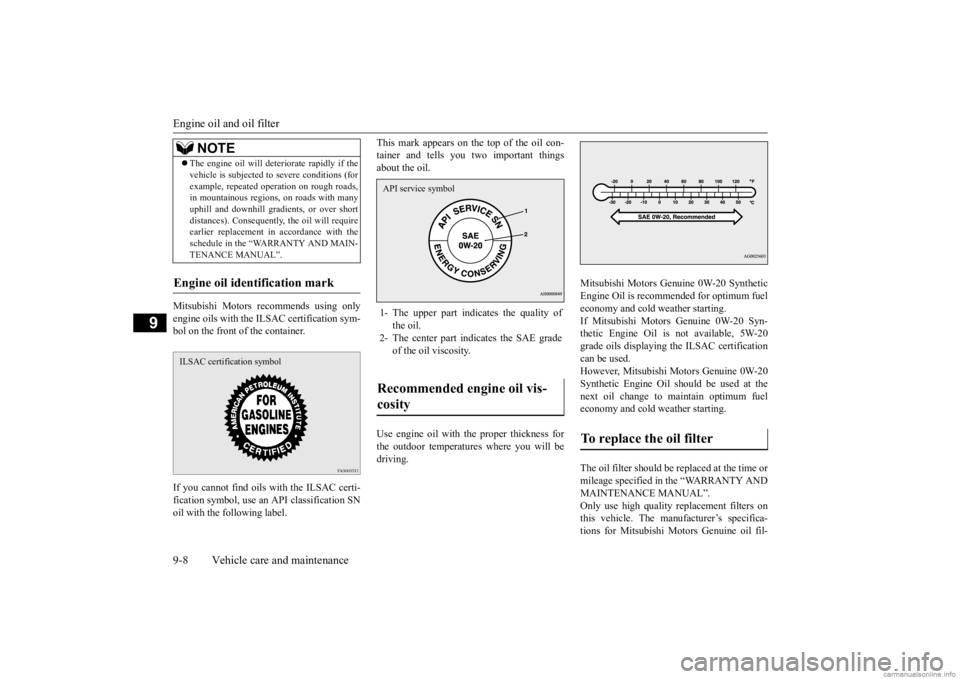
Engine oil and oil filter 9-8 Vehicle care and maintenance
9
Mitsubishi Motors recommends using only engine oils with the
ILSAC certification sym-
bol on the front of the container. If you cannot find oils with the ILSAC certi- fication symbol, use an API classification SN oil with the following label.
This mark appears on the top of the oil con- tainer and tells you two important thingsabout the oil. Use engine oil with the proper thickness for the outdoor temperatures where you will bedriving.
Mitsubishi Motors Genuine 0W-20 Synthetic Engine Oil is recomm
ended for optimum fuel
economy and cold weather starting. If Mitsubishi Motors Genuine 0W-20 Syn- thetic Engine Oil is
not available, 5W-20
grade oils displaying the ILSAC certification can be used. However, Mitsubishi Motors Genuine 0W-20Synthetic Engine Oil s
hould be used at the
next oil change to maintain optimum fuel economy and cold weather starting. The oil filter should be
replaced at the time or
mileage specified in
the “WARRANTY AND
MAINTENANCE MANUAL”. Only use high quality
replacement filters on
this vehicle. The manufacturer’s specifica-tions for Mitsubishi Motors Genuine oil fil-
The engine oil wi
ll deteriorate rapidly if the
vehicle is subjected to
severe conditions (for
example, repeated operation on rough roads,in mountainous regions, on roads with many uphill and downhill grad
ients, or over short
distances). Consequently
, the oil will require
earlier replacement in accordance with the schedule in the “WARRANTY AND MAIN- TENANCE MANUAL”.
Engine oil identification mark
NOTE
ILSAC certification symbol
1- The upper part indicates the quality of
the oil.
2- The center part indicates the SAE grade
of the oil viscosity.
Recommended engine oil vis- cosity API service symbol
To replace the oil filter
BK0278200US.book 8 ページ 2019年4月10日 水曜日 午前10時59分
Page 387 of 443
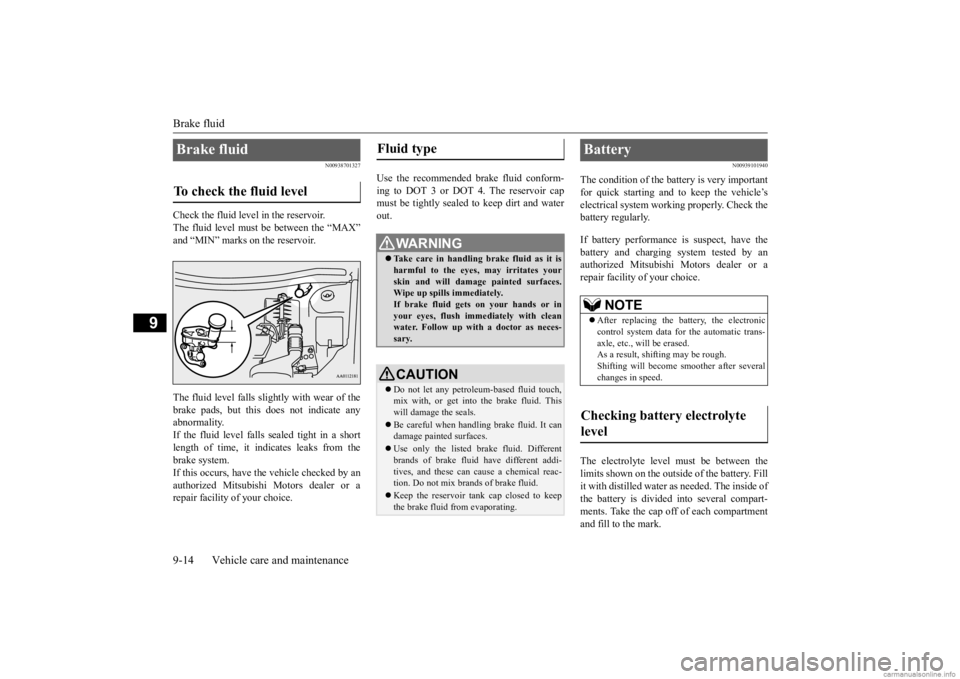
Brake fluid 9-14 Vehicle care and maintenance
9
N00938701327
Check the fluid level in the reservoir. The fluid level must be between the “MAX” and “MIN” marks on the reservoir. The fluid level falls slightly with wear of the brake pads, but this
does not indicate any
abnormality.If the fluid level falls se
aled tight in a short
length of time, it indi
cates leaks from the
brake system.If this occurs, have the vehicle checked by an authorized Mitsubishi Motors dealer or a repair facility of your choice.
Use the recommended brake fluid conform- ing to DOT 3 or DOT 4. The reservoir cap must be tightly sealed to keep dirt and waterout.
N00939101940
The condition of the battery is very important for quick starting and to keep the vehicle’s electrical system working properly. Check thebattery regularly. If battery performance is suspect, have the battery and charging system tested by an authorized Mitsubishi Motors dealer or a repair facility of your choice. The electrolyte level
must be between the
limits shown on the outside
of the battery. Fill
it with distilled water
as needed. The inside of
the battery is divided into several compart- ments. Take the cap off of each compartment and fill to the mark.
Brake fluid To check the fluid level
Fluid type
WA R N I N G Take care in handling brake fluid as it is harmful to the eyes, may irritates yourskin and will damage
painted surfaces.
Wipe up spills immediately. If brake fluid gets on your hands or inyour eyes, flush imme
diately with clean
water. Follow up with a doctor as neces- sary.CAUTION Do not let any petrol
eum-based fluid touch,
mix with, or get into the brake fluid. This will damage the seals. Be careful when handling brake fluid. It can damage painted surfaces. Use only the listed brake fluid. Different brands of brake fluid have different addi- tives, and these can cause a chemical reac- tion. Do not mix brands of brake fluid. Keep the reservoir ta
nk cap closed to keep
the brake fluid from evaporating.
Battery
NOTE
After replacing the battery, the electronic control system data for the automatic trans-axle, etc., will be erased. As a result, shifting may be rough. Shifting will become smoother after severalchanges in speed.
Checking battery electrolyte level
BK0278200US.book 14 ページ 2019年4月10日 水曜日 午前10時59分
Page 393 of 443
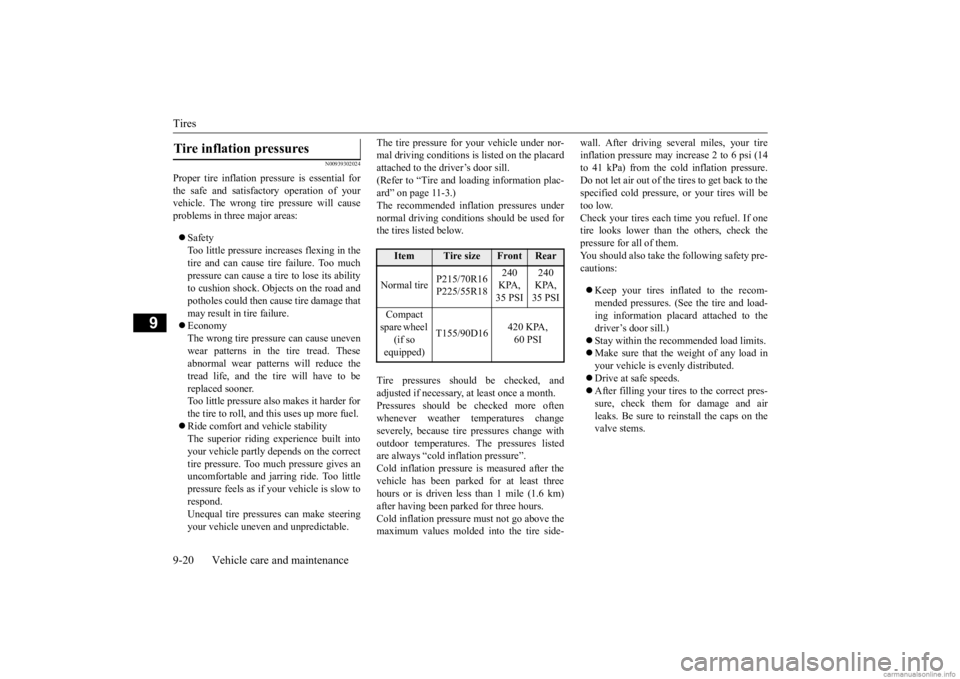
Tires 9-20 Vehicle care and maintenance
9
N00939302024
Proper tire inflation pres
sure is essential for
the safe and satisfactory operation of your vehicle. The wrong tire
pressure will cause
problems in three major areas: Safety Too little pressure increases flexing in the tire and can cause tire failure. Too much pressure can cause a tire to lose its ability to cushion shock. Objects on the road andpotholes could then cause tire damage that may result in tire failure. Economy The wrong tire pressure can cause uneven wear patterns in the tire tread. These abnormal wear patterns will reduce thetread life, and the tire will have to be replaced sooner. Too little pressure also makes it harder forthe tire to roll, and this uses up more fuel. Ride comfort and vehicle stability The superior riding
experience built into
your vehicle partly depends on the correct tire pressure. Too mu
ch pressure gives an
uncomfortable and ja
rring ride. Too little
pressure feels as if your vehicle is slow to respond. Unequal tire pressures can make steeringyour vehicle uneven and unpredictable.
The tire pressure for your vehicle under nor- mal driving conditions is listed on the placardattached to the driver’s door sill. (Refer to “Tire and loading information plac- ard” on page 11-3.)The recommended infl
ation pressures under
normal driving conditions should be used for the tires listed below. Tire pressures should be checked, and adjusted if necessary, at least once a month. Pressures should be checked more often whenever weather temperatures changeseverely, becaus
e tire pressures change with
outdoor temperatures. The pressures listed are always “cold inflation pressure”.Cold inflation pressure is measured after the vehicle has been parked
for at least three
hours or is driven less than 1 mile (1.6 km)after having been parked for three hours. Cold inflation pressure must not go above the maximum values molded into the tire side-
wall. After driving seve
ral miles, your tire
inflation pressure may increase 2 to 6 psi (14to 41 kPa) from the cold inflation pressure. Do not let air out of the tires to get back to the specified cold pressure, or your tires will betoo low. Check your tires each time you refuel. If one tire looks lower than the others, check thepressure for all of them. You should also take the following safety pre- cautions: Keep your tires inflated to the recom- mended pressures. (See the tire and load- ing information placard attached to thedriver’s door sill.) Stay within the recommended load limits. Make sure that the weight of any load in your vehicle is evenly distributed. Drive at safe speeds. After filling your tires to the correct pres- sure, check them for damage and air leaks. Be sure to reinstall the caps on the valve stems.
Tire inflation pressures
Item
Tire size
Front
Rear
Normal tire
P215/70R16 P225/55R18
240 KPA, 35 PSI
240 KPA, 35 PSI
Compact spare wheel
(if so equipped)
T155/90D16
420 KPA, 60 PSI
BK0278200US.book 20 ページ 2019年4月10日 水曜日 午前10時59分
Page 399 of 443
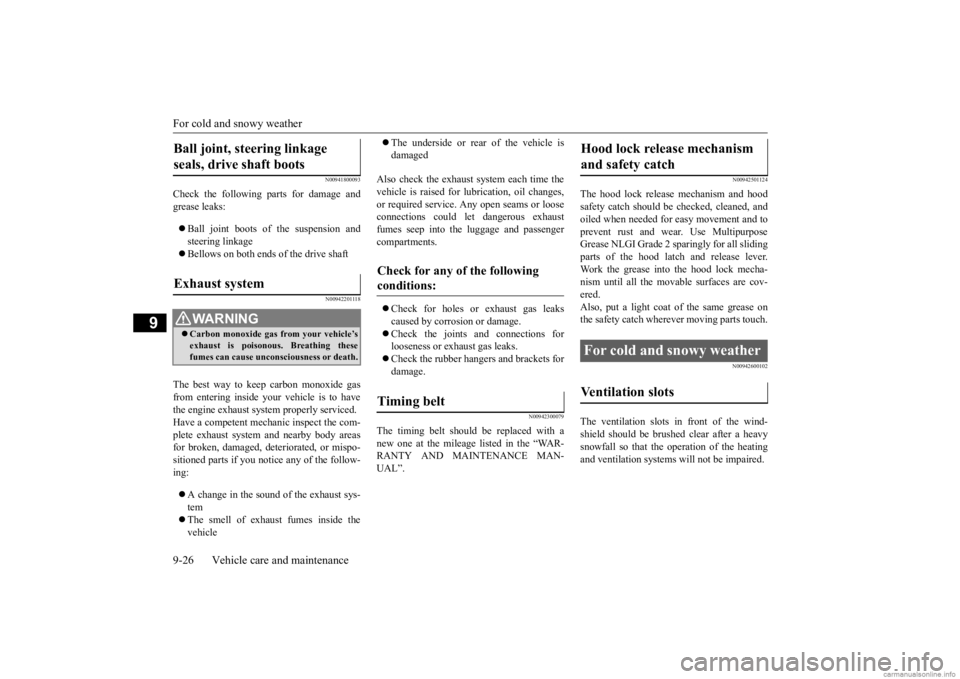
For cold and snowy weather 9-26 Vehicle care and maintenance
9
N00941800093
Check the following parts for damage and grease leaks: Ball joint boots of the suspension and steering linkage Bellows on both ends of the drive shaft
N00942201118
The best way to keep carbon monoxide gas from entering inside your
vehicle is to have
the engine exhaust syst
em properly serviced.
Have a competent mechanic inspect the com- plete exhaust system
and nearby body areas
for broken, damaged, deteriorated, or mispo- sitioned parts if you no
tice any of the follow-
ing: A change in the sound of the exhaust sys- tem The smell of exhaust fumes inside the vehicle
The underside or rear of the vehicle is damaged
Also check the exhaust system each time the vehicle is raised for l
ubrication, oil changes,
or required service.
Any open seams or loose
connections could le
t dangerous exhaust
fumes seep into the luggage and passenger compartments. Check for holes or exhaust gas leaks caused by corrosion or damage. Check the joints and connections for looseness or exhaust gas leaks. Check the rubber hangers and brackets for damage.
N00942300079
The timing belt should be replaced with anew one at the mileage listed in the “WAR- RANTY AND MAINTENANCE MAN-UAL”.
N00942501124
The hood lock release mechanism and hoodsafety catch should be checked, cleaned, andoiled when needed for easy movement and to prevent rust and wear. Use Multipurpose Grease NLGI Grade 2 sparingly for all slidingparts of the hood latch and release lever. Work the grease into the hood lock mecha- nism until all the movable surfaces are cov- ered. Also, put a light coat
of the same grease on
the safety catch wherever moving parts touch.
N00942600102
The ventilation slots in
front of the wind-
shield should be brushed clear after a heavy snowfall so that the operation of the heating and ventilation
systems will not be impaired.
Ball joint, steering linkage seals, drive shaft boots Exhaust system
WA R N I N G Carbon monoxide gas
from your vehicle’s
exhaust is poisonous. Breathing thesefumes can cause unconsciousness or death.
Check for any of the following conditions: Timing belt
Hood lock release mechanism and safety catch For cold and snowy weather Ventilation slots
BK0278200US.book 26 ページ 2019年4月10日 水曜日 午前10時59分
Page 435 of 443

Alphabetical index 12-2
12
Fluid
....................................
9-12
, 11-7
Selector lever operation
...................
5-77
Selector le
ver positions
...................
5-80
Sports mode
...................................
5-81
Coolant (engine)
..........................
9-9
, 11-7
Cruise control
...................................
5-103
Cup holder
.......................................
5-235
D
Daytime running lights
Bulb capacity
.................................
9-34
Replacement
..................................
9-38
Defogger (rear window)
....................
5-216
Defrosting or defogging (windshield, door windows)
..................................
7-9
, 7-13
Dimensions
........................................
11-4
Dimmer (high/lo
w beam change)
.......
5-202
Disc brake pads
..................................
9-25
Dome light (front)/Reading lights
.......
5-229
Bulb capacity
.................................
9-35
Dome light (rear)
..............................
5-229
Bulb capacity
.................................
9-35
Doors
Lock
..............................................
5-36
Power door locks
............................
5-38
Downlight
........................................
5-231
Driving during cold weather
..................
6-5
Driving precaution
................................
6-2
Driving, alcohol and drugs
....................
6-2
Dual-zone automatic climate control air conditioner
........................................
7-5
E
ECO mode switch
.............................
5-209
Electric parking brake
..........................
5-57
Electric power steering system (EPS)
....
5-99
Electric rear window
defogger switch
..5-216
Electronic immobilizer (Anti-theft starting system)
.....................................
5-4
, 5-29
Electronically cont
rolled 4WD system
..5-83
Emission-control system maintenance
...
9-24
Engine
Compartment
...................................
9-6
Coolant
...................................
9-9
, 11-7
Hood
...............................................
9-3
Malfunction indicator light
.............
5-197
MIVEC
.................................
5-27
, 5-70
Oil and oil filter
.......................
9-7
, 11-7
Overheating
.....................................
8-4
Serial number
.................................
11-2
Specification
...................................
11-6
Engine hood
........................................
9-3
Engine switch
.....................................
5-19
Event Data Recording
...........................
3-7
Exhaust system
...................................
9-26
F
Floor console box
.............................
5-233
Floor mat
.............................................
6-3
Fluid
Automatic transaxle fluid
.......
9-12
, 11-7
Brake fluid
............................
9-14
, 11-7
Continuously variable transmission (CVT) fluid
...................................
9-12
, 11-7
Engine coolant
........................
9-9
, 11-7
Engine oil
...............................
9-7
, 11-7
Rear axle oil
..........................
9-13
, 11-7
Transfer oil
...........................
9-13
, 11-7
Washer fluid
.........................
9-13
, 11-7
Fluid capacities and lubricants
.............
11-7
Forward Collision Miti
gation System (FCM)
5-118 Free-hand advanced security transmitter (F.A.S.T.-key)
..................................
5-15
Front fog lights
Bulb capacity
.................................
9-34
Indicators
.....................................
5-195
Replacement
..................................
9-39
Switch
.........................................
5-209
Front side-marker lights
Bulb capacity
.................................
9-34
Replacement
..................................
9-37
Front turn signal light
Bulb capacity
.................................
9-34
Replacement
..................................
9-38
BK0278200US.book 2 ページ 2019年4月10日 水曜日 午前10時59分